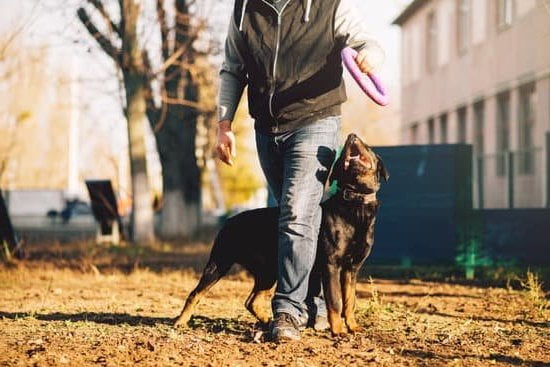What do you learn when you train seeing eye dogs? Training seeing eye dogs goes beyond the basic obedience commands and handling techniques. It involves gaining a deep understanding of canine behavior, effective communication with animals, developing empathy and compassion, and recognizing the challenges faced by the visually impaired.
The training process for seeing eye dogs is a unique and fulfilling experience that offers valuable lessons about patience and perseverance. Through this process, trainers also gain insights into the strong bond that forms between seeing eye dogs and their handlers, as well as the impact of these highly trained animals on the lives of visually impaired individuals.
Training seeing eye dogs provides an opportunity to develop a deeper understanding of canine behavior and communication. This includes learning about different breeds, temperament traits, and how to effectively communicate with a dog through body language, vocal cues, and positive reinforcement. Additionally, trainers gain insight into the specific skills required for a dog to become a successful guide for someone who is visually impaired.
The Training Process for Seeing Eye Dogs
Basic Obedience and Socialization
One of the fundamental aspects of training seeing eye dogs is teaching them basic obedience commands and proper socialization. This includes commands such as sit, stay, come, and heel, as well as exposing the dogs to various social settings and environments. By mastering these foundational skills, the dogs are better equipped to focus on their handler’s needs while maintaining composure in different situations.
Navigation Skills
Seeing eye dogs undergo extensive training to learn how to navigate through different types of terrain, including sidewalks, stairs, and crowded areas. They are taught to recognize obstacles and hazards, such as low-hanging branches or uneven surfaces, and guide their handler around them safely. Additionally, they are trained to stop at curbs and steps, providing clear communication to their handler about changes in elevation.
Transitioning From Training to Partnership
As the training progresses, seeing eye dogs begin to form a strong bond with their future handlers through supervised interactions. This transition phase is crucial in establishing trust and understanding between the dog and its human companion. Handlers also receive instruction on how to effectively communicate with and care for their seeing eye dog, allowing for a smooth transition into a working partnership once the training is completed.
What do you learn when you train seeing eye dogs? Throughout the training process for seeing eye dogs, trainers gain valuable insights into canine behavior and communication which assists in preparing these remarkable animals for their important role as guides for visually impaired individuals.
The experience also fosters a deeper understanding of patience perseverance as well as empathy compassion towards both the challenges faced by visually impaired individuals and the fulfilling impact of assisting them through this unique form of service.
What You Learn About Canine Behavior and Communication
Seeing eye dog training provides a unique opportunity to gain insight into canine behavior and communication. During the training process, individuals learn how dogs communicate with each other and with humans, as well as how they respond to different cues and commands. Understanding canine behavior is crucial in order to effectively train seeing eye dogs to assist visually impaired individuals.
One important aspect of learning about canine behavior and communication during seeing eye dog training is recognizing the body language and vocalizations of the dog. Trainers must be able to interpret subtle signals from the dog in order to respond appropriately and address any issues that may arise during the training process. This includes understanding signs of stress, anxiety, or discomfort in the dog, as well as recognizing when the dog is focused, relaxed, or engaged.
In addition, seeing eye dog training also provides an opportunity to learn about the ways in which dogs communicate with their handlers. This includes understanding how dogs respond to praise, rewards, and redirection, as well as how they form strong bonds with their human companions. By learning about canine behavior and communication, individuals who participate in seeing eye dog training develop a deeper appreciation for the intelligence and sensitivity of these animals.
| Canine Behavior | Communication |
|---|---|
| Interpreting body language | Recognition of vocalizations |
| Understanding stress signals | Response to praise and rewards |
| Bond formation with human companions | Sensitivity of animals |
Understanding the Bond Between Seeing Eye Dogs and Their Handlers
The bond between seeing eye dogs and their handlers is a crucial aspect of the training process. It is essential for these dogs to form a strong, trusting relationship with their visually impaired owners in order to effectively guide them and keep them safe. During the training process, individuals learn firsthand about the development of this unique and life-changing bond.
One important aspect that trainees learn about is the communication between seeing eye dogs and their handlers. They learn to understand how these dogs use body language, vocal cues, and subtle actions to communicate with their visually impaired owners. This understanding helps trainees facilitate and strengthen the bond between the two, ultimately leading to a successful partnership.
Furthermore, those involved in training seeing eye dogs also gain insights into canine behavior. Understanding the individual quirks, habits, and personalities of these animals is crucial in matching them with suitable visually impaired individuals. This knowledge not only aids in creating successful partnerships but also allows for a deeper understanding of canine behavior as a whole.
| Aspect | Details |
|---|---|
| Communication | Understanding how seeing eye dogs communicate with their handlers through body language and vocal cues |
| Behavior | Gaining insights into canine behavior and personality traits to facilitate successful matches with visually impaired individuals |
| Bond Development | Learning about the process of building a strong, trusting bond between seeing eye dogs and their handlers during training |
Patience and Perseverance
Training seeing eye dogs requires a significant amount of patience and perseverance. This section will delve into the valuable lessons that individuals can learn through the training process, ultimately shaping their personal growth and contribution to the community.
Understanding the Challenges
One of the key lessons learned through training seeing eye dogs is understanding the challenges faced by both the visually impaired individuals and their canine companions. This experience provides a firsthand insight into the daily obstacles that visually impaired individuals encounter, from navigating busy streets to accessing public spaces.
It also sheds light on the difficulties that arise during the training process, such as teaching dogs to safely guide their handlers through various obstacles. By grappling with these challenges, trainers gain a deeper understanding of empathy and compassion towards those living with visual impairments.
Developing Resilience
Training seeing eye dogs involves numerous setbacks and obstacles, which in turn fosters resilience among trainers. From basic obedience training to advanced guiding skills, each step in the process requires consistent practice and patience. Trainers must learn to adapt to different personalities and temperaments in order to effectively communicate with and guide their canine companions. Through this constant perseverance, individuals hone their ability to overcome adversity and develop greater patience in both personal and professional aspects of life.
Fostering Commitment
Another crucial lesson from training seeing eye dogs is fostering commitment towards a greater cause. The dedication required for successfully training a seeing eye dog instills a sense of purpose and fulfillment in contributing to the community.
The bond formed between handler and dog is based on trust, communication, and unwavering commitment – all valuable qualities that are developed through this process. As trainers witness firsthand how their efforts positively impact the lives of visually impaired individuals, they gain a strong sense of fulfillment from knowing they have made a meaningful difference in someone else’s life.
What You Learn About the Challenges Faced by the Visually Impaired
Training seeing eye dogs provides valuable insight into the challenges faced by the visually impaired. By working closely with individuals who rely on these specially trained dogs for assistance, trainers gain a deeper understanding of the hurdles that these individuals encounter on a daily basis. Here are some key insights that can be gained through this type of training:
- The importance of independence: One of the most significant challenges faced by the visually impaired is maintaining a sense of independence. Through seeing eye dog training, individuals learn about the ways in which these dogs enable their handlers to navigate the world with greater freedom and autonomy.
- Navigating obstacles: Trainers gain an appreciation for the physical obstacles and barriers that can pose significant challenges for those who are visually impaired. This includes everything from crowded streets and uneven pavement to navigating public transportation and busy environments.
- Social interactions: Another aspect that trainers learn about during seeing eye dog training is the impact that visual impairment can have on social interactions. They become aware of how individuals may struggle to engage in conversations or interact with others in unfamiliar settings, leading to feelings of isolation and exclusion.
By gaining a deeper understanding of these challenges, trainers can develop a heightened sense of empathy and compassion for those who are visually impaired. This learning experience not only enhances their ability to train seeing eye dogs effectively but also contributes to personal growth and a greater awareness of how they can support individuals with visual impairments in their communities.
Developing Empathy and Compassion Through Seeing Eye Dog Training
Seeing eye dog training goes beyond just teaching dogs how to guide visually impaired individuals. It also provides a unique opportunity for trainers to develop empathy and compassion. Working closely with these specially trained dogs allows individuals to better understand the challenges faced by visually impaired people on a daily basis.
Through the process of seeing eye dog training, individuals learn to see the world from a different perspective. They gain insight into the obstacles and barriers that visually impaired individuals encounter, as well as the importance of independence and mobility. This understanding fosters empathy and compassion, as trainers become more attuned to the needs and experiences of those living with visual impairment.
Additionally, seeing eye dog training encourages individuals to develop a greater sense of patience and understanding. Trainers must learn to communicate effectively with both the dogs and their future handlers, recognizing that clear communication is essential in helping visually impaired individuals navigate the world around them.
This heightened awareness of communication methods can also be applied to interactions with other people, leading to more empathetic and compassionate relationships in all areas of life. Through this process, trainers not only contribute positively to their community but also experience personal growth as they cultivate a deeper understanding of empathy and compassion.
Overall, seeing eye dog training is not just about teaching dogs specific tasks; it is also about fostering empathy, understanding, and compassion towards visually impaired individuals. Through this unique form of training, individuals can grow personally while making a positive impact on the lives of others within their community.
The Fulfillment of Helping Others Through Seeing Eye Dog Training
Seeing eye dog training goes beyond just learning how to work with and communicate with dogs. It also offers a unique opportunity to experience the fulfillment of helping others in a meaningful way. Here are some key aspects of this aspect of training seeing eye dogs:
- Impact on Visually Impaired Individuals: Seeing eye dog training allows individuals to directly impact the lives of visually impaired individuals. By training these dogs, individuals are contributing to the independence and safety of those who rely on them for assistance in their daily lives.
- Sense of Purpose: Training seeing eye dogs provides a sense of purpose and fulfillment that comes from knowing that you are making a positive difference in the world. It can be incredibly rewarding to see the impact that a well-trained seeing eye dog has on its handler, as well as the larger community.
- Developing Empathy and Compassion: Through this training, individuals have the opportunity to develop a deep sense of empathy and compassion for those who are visually impaired. This experience can lead to greater understanding and sensitivity towards the challenges faced by individuals with disabilities, ultimately making them more empathetic members of society.
This kind of hands-on experience allows participants to gain insight into what it means to truly make a difference in someone else’s life. The fulfillment that comes from helping others through seeing eye dog training is unparalleled, and it leaves a lasting impact on all those involved in the process.
Conclusion
In conclusion, training seeing eye dogs not only provides valuable assistance to the visually impaired community but also offers a transformative learning experience for the trainers. Through this process, individuals gain a deep understanding of canine behavior and communication, as well as the unique bond between seeing eye dogs and their handlers. This knowledge fosters empathy, patience, and perseverance, essential qualities that contribute to personal growth and enrich one’s ability to contribute to the community.
Moreover, training seeing eye dogs allows individuals to develop a profound sense of empathy and compassion for the challenges faced by the visually impaired. This firsthand experience enables trainers to better understand the daily obstacles and societal barriers that visually impaired individuals encounter. As a result, they become more sensitive to the needs of others and are motivated to make a positive impact on their community.
Ultimately, engaging in seeing eye dog training is an immensely fulfilling endeavor that not only benefits the visually impaired but also enhances personal growth while making a meaningful contribution to society. By imparting invaluable life lessons about patience, empathy, and perseverance, this training experience leaves a lasting impact on individuals who choose to dedicate themselves to this noble cause.
So what do you learn when you train seeing eye dogs? It turns out that it’s not just about training dogs-it’s about gaining a deeper understanding of oneself, others, and how best to contribute positively to society.
Frequently Asked Questions
What Are Seeing Eye Dogs Trained to Do?
Seeing Eye dogs are trained to assist individuals who are blind or visually impaired by guiding them around obstacles, stopping at curbs, avoiding obstructions, and navigating through crowded areas safely.
What Are the Benefits of Seeing Eye Dogs?
The benefits of having a Seeing Eye dog include increased independence for the individual, improved safety when navigating through various environments, and enhanced mobility and confidence in daily activities.
How Do Seeing Eye Dogs Know Where to Take You?
Seeing Eye dogs are trained to follow verbal commands from their handlers and also utilize their intelligence, memory, and sensory perception to recognize familiar routes, landmarks, and cues from environmental changes to guide their handlers effectively.

Welcome to the blog! I am a professional dog trainer and have been working with dogs for many years. In this blog, I will be discussing various topics related to dog training, including tips, tricks, and advice. I hope you find this information helpful and informative. Thanks for reading!





